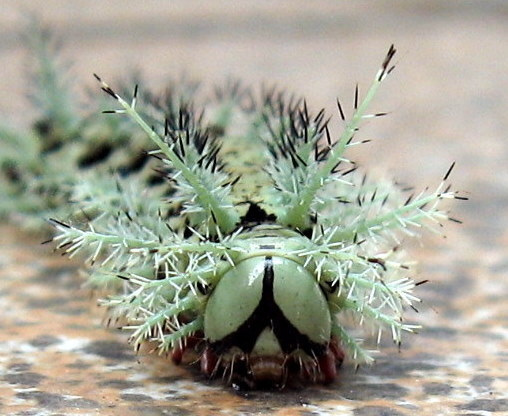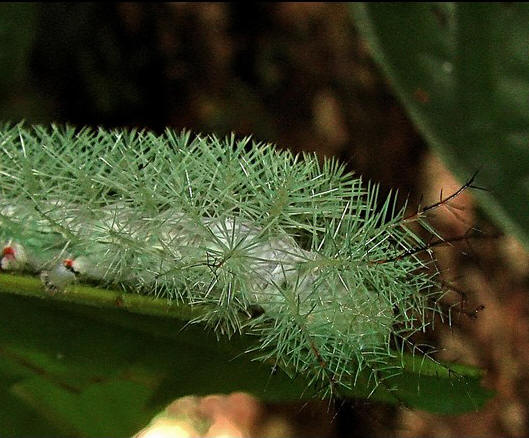Venom
The thing that makes the Lonomia obliqua so special for caterpillars and deadly is its venom. It’s considered to have one of the most deadly venoms and is equal to that of rattlesnakes. People most often come in contact with this caterpillar in the rainforests of Brazil. They unknowingly touch a tree or branches with the caterpillar and come in contact with this deadly venom. The venom comes from the bristles on the back of the caterpillar. A common first sign you may have touched this deadly caterpillar is a burning sensation at the contact site along with pain and redness (Nascimento-Silva, et al 2012)). Other symptoms may include swelling and bruising along the contact site and possibly at other locations on the body (Nascimento-Silva, et al 2012). The severity of the envenomation depends on several factors including the amount of venom injected, the size of the area affected, and the depth of the injection of venom (Ricci-Silva et al. 2008).
 A wide variety of symptoms can occur
from a contact with the L. obliqua caterpillar. The obvious first
sign is a burning sensation at contact site along with pain and redness at
the site (Ricci-Silva et al. 2008). The next symptoms include swelling and
bruising all over the body especially at the contact sites, along with headaches,
nausea and bloody urine (Nascimento-Silva, et al 2012 and Ricci-Silva et al.
2008). The venom causes several long term effects on humans with the
most severe being hemorrhagic syndrome. This is the body being unable to
clot blood leading to massive internal bleeding which ultimately causes
blood instability (Nascimento-Silva, et al 2012 and Ricci-Silva et al.
2008). Other severe symptoms include fibrinolysis which is causes
bloods clots not to form when the person is likely already suffering from internal
bleeding, and kidney failure (Nascimento-Silva, et al 2012 and Ricci-Silva
et al. 2008). Brain bleeds and pulmonary hemorrhages along with
hemolysis, which is the breakdown of blood cells causing them to burst into
the surrounding areas, also occur because of the venom (Nascimento-Silva, et
al 2012 and Ricci-Silva et al. 2008). The venom causes many severe
reactions that one must seek immediate medical attention from when they know
they may have come in contact with this caterpillar.
A wide variety of symptoms can occur
from a contact with the L. obliqua caterpillar. The obvious first
sign is a burning sensation at contact site along with pain and redness at
the site (Ricci-Silva et al. 2008). The next symptoms include swelling and
bruising all over the body especially at the contact sites, along with headaches,
nausea and bloody urine (Nascimento-Silva, et al 2012 and Ricci-Silva et al.
2008). The venom causes several long term effects on humans with the
most severe being hemorrhagic syndrome. This is the body being unable to
clot blood leading to massive internal bleeding which ultimately causes
blood instability (Nascimento-Silva, et al 2012 and Ricci-Silva et al.
2008). Other severe symptoms include fibrinolysis which is causes
bloods clots not to form when the person is likely already suffering from internal
bleeding, and kidney failure (Nascimento-Silva, et al 2012 and Ricci-Silva
et al. 2008). Brain bleeds and pulmonary hemorrhages along with
hemolysis, which is the breakdown of blood cells causing them to burst into
the surrounding areas, also occur because of the venom (Nascimento-Silva, et
al 2012 and Ricci-Silva et al. 2008). The venom causes many severe
reactions that one must seek immediate medical attention from when they know
they may have come in contact with this caterpillar.
The first cases of Lonomia obliqua envenomation occurred in the early 1900’s when a patient complained of hemorrhagic syndrome. Starting in 1969, more scientific research has occurred. Since 1989, L. obliqua has been associated with human incidents in the southern part of Brazil, where it is considered to be an epidemic (Chudzinski-Tavassi and Carrijo-Carvalho 2006). More incidents have been noted as its habitat has expanded over Brazil and other countries. Most victim’s site of contact is the hands. The current death rate is about 2.5%. This may not be a high number but the venom has very serious effects on people and is need of immediate medical attention.
There is hope if you happen to envenomed by this deadly caterpillar as an
anti-venom has been developed. The Buntantan Institute in Sao Paulo, Brazil
developed a specific anti-venom for envenomation caused by L. obliqua. It
has been known to help the blood instability and bleeding in humans. The
 main course of treatment is to hopefully seek medical attention within the
first 12 hours in order to stop problems with clotting. After the anti-venom
was introduced no known deaths have occurred (Chudzinski-Tavassi and
Carrijo-Carvalho 2006).
main course of treatment is to hopefully seek medical attention within the
first 12 hours in order to stop problems with clotting. After the anti-venom
was introduced no known deaths have occurred (Chudzinski-Tavassi and
Carrijo-Carvalho 2006).
The venom does not just affect humans. Studies have been done on mice to help further understand the venom. The discovered lethal dose in rats is 10 mg/kg (Carrijo-Carvalho and Chudzinski-Tavassi 2007). There has been indications that in envenomed rats also have the some of the same symptoms as humans including kidney failure and brain bleeding (Carrijo-Carvalho and Chudzinski-Tavassi 2007). This is mostly due to the damage done to the tissues since the venom causes damage to the brain barrier (Carrijo-Carvalho and Chudzinski-Tavassi 2007). Even with studies, little is known about how the mechanism by which the damage the venom works occurs (Carrijo-Carvalho and Chudzinski-Tavassi 2007). As venom has been discovered all over the body even after an anti-venom has been given to the patient whether it be a human or rats Carrijo-Carvalho and Chudzinski-Tavassi 2007). This is likely due to the issues with blood the venom causes. Efforts to further understand the venom are currently in the works to discover why this may occur.
One study tried to establish what actually makes up the venom of the bristles on the caterpillar. They discovered that is it had dozens of full length complementary DNA that also code for proteins with similar homology to that of snake venom that had prothrombin activator and blood coagulation factors (Veiga et al. 2005). Other cDNA was discovered but the venom sequences do not match anything else and still needs to be discovered more (Veiga et al. 2005). A protease inhibitor is one the main things that has been discovered in the venom which is found in many arthropods and protects them from pathogens (Veiga et al. 2005). The L. obliqua’s venom holds many proteins that effect the envenomed individual. These proteins are similar to those of other venomous creatures yet so much is yet to be discovered about these caterpillars venom and what composes it.
Next you can learn all about the reproduction
of this caterpillar.